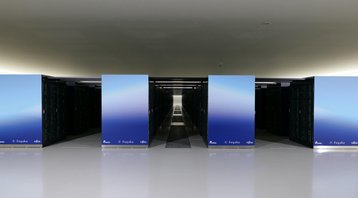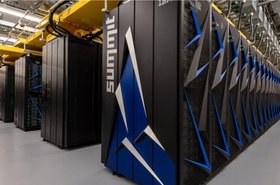The latest ranking of the top 500 fastest supercomputers has seen little change since its last tabulation six months ago.
Japan's Arm-powered Fugaku still dominates the Top500 list, and only one new system has entered the top 10 - NERSC's 64.6 petaflops Perlmutter supercomputer.
The fastest supercomputers
Fugaku scored 442 petaflops on the HPL benchmark, with 7,630,848 cores. That's the same as it achieved in November 2020, but above the 415.53 petaflops it managed this time last year when it first topped the list.
The supercomputer is based on Fujitsu's custom Arm A64FX processor, and does not use a GPU.
Next is the Oak Ridge National Laboratory's 148.8 petaflops Summit supercomputer, now nearly three years old. It uses 27,000 Nvidia Tesla V100 GPUs linked to 9,000 IBM Power9 CPUs.
Then comes the similarly-designed Sierra supercomputer, run out of Lawrence Livermore National Laboratory, and capable of 94.6 petaflops.
China comes in fourth, with the Sunway TaihuLight achieving 93 petaflops using Sunway SW26010 processors. It is now five years old.
Below it is Perlmutter, the first HPE Cray Shasta system, with a heterogeneous architecture boasting both AMD Epyc CPUS and Nvidia A100 GPUs.
At six is Selene, Nvidia's in-house corporate supercomputer. As you'd expect, it's made out of a lot of Nvidia DGX A100 SuperPODs, and can reach 63.4 petaflops.
China again comes into the top 10 at seven with the Tianhe-2A, capable of 61.4 petaflops.
Europe's most powerful supercomputer is the "JUWELS Booster Module," an Atos BullSequana supercomputer with Epyc CPUs and A100 GPUs. Located in Germany, it's capable of 44.1 petaflops.
Another corporate system comes in next, creatively titled HPC5. Used by Italian fossil fuel giant Eni, it's reached 35.5 petaflops using Nvidia Tesla V100 accelerators.
Rounding out the list is the Texas Advanced Computing Center of the University of Texas' Frontera supercomputer. When it is not shut down due to storms, it can reach 23.5 petaflops with 448,448 Intel Xeon cores.
Beyond the top 10
While the fastest supercomputers saw little change, there is more that can be learned from the rest of the list.
AMD performed strongly, with Top500 noting a "marked increase" in its use. This is matched by AMD's overall advances in the server and HPC space, taking share from Intel.
Cloud also grew, with no.24 Pioneer-EUS and no.27 Pioneer-WUS2 both being Microsoft Azure instances (the company also claims it built a top 5 system for OpenAI). The Amazon EC2 Instance Cluster at No. 41 utilizes Amazon EC2, as the name suggests.
China still dominated the list with the most systems by raw number (186), but that was down considerably from the previous ranking (212).
The US, meanwhile, was up from 113 to 123. Those systems were more powerful cumulatively, too, with an aggregate performance of 856.8 petaflops, compared to China's 445.3 petaflops.
The Top500 noted that there "hasn't been much definitive proof of why [China's lackluster performance] is happening," although it may be to do with mounting sanctions against Chinese HPC firms. These both make it harder for companies and research labs to source supercomputing equipment and less likely for them to take part in a voluntary ranking system that may put them in regulators' crosshairs.
The country had once hoped to launch an exascale supercomputer (that is, 1,000 petaflops) by 2020, but such a target has been repeatedly pushed back.
China has challenged the National University of Defense Technology (NUDT), the National Research Center of Parallel Computer Engineering and Technology (NRCPC), and server maker Sugon (now sanctioned) with each coming up with an exascale supercomputer.
We now have some insight into the approach used by one of the groups to replace the Sunway TaihuLight system installed at the National Supercomputing Center in Wuxi, but definitive deadlines are still lacking.
The US' own exascale plans have also been beset by a fair number of delays. Its first exascale supercomputer was originally planned only as the result of delays around its Aurora supercomputer. The Intel-powered machine was meant to come out in 2018 as a 180 petaflops system, but the government pushed it back and upgraded it to an exascale system after the company canceled the chip that was meant to power it. However, Intel is still struggling to develop the required new chips, pushing back Aurora even further.
As it stands, the US is meant to launch the 1.5 exaflops Frontier supercomputer this year, featuring AMD CPUs and GPUs. It will be based on Cray’s Shasta architecture and Slingshot interconnect, found in Perlmutter.


